Android进阶宝典 -- JetPack Navigation的高级用法(解决路由跳转新建Fragment页面问题)
Posted datian1234
tags:
篇首语:本文由小常识网(cha138.com)小编为大家整理,主要介绍了Android进阶宝典 -- JetPack Navigation的高级用法(解决路由跳转新建Fragment页面问题)相关的知识,希望对你有一定的参考价值。
相信有相当一部分的伙伴,在项目开发中依然使用Activity作为页面承载体,有10个页面就会有10个Activity,这种方式当然没问题,但是如果涉及到页面间数据共享,那么使用多Activity就不是很方便了,需要Activity传递各种数据,涉及到数据的序列化与反序列化;因此产生了单Activity和多Fragment架构,所有的Fragment可以共享Activity中的数据,不需要数据传递便可操作数据,而且Fragment相较于Activity更加轻量级。
但是为什么之前使用这种架构很少呢?是因为Fragment切换以及回退栈管理比较复杂,但是Navigation出现之后,局面完全逆转了,很多人都在尝试使用单Activity和多Fragment架构,那么本节就着重介绍Navigation的使用方式。
1 Navigation的基础使用
本文主要以单Activity和多Fragment架构为例介绍
//依赖配置
implementation 'androidx.navigation:navigation-fragment-ktx:2.5.2'
implementation 'androidx.navigation:navigation-ui-ktx:2.5.2'
准备工作1:创建路由表,存储Fragment页面

准备工作2:创建多个Fragment
<?xml version="1.0" encoding="utf-8"?>
<navigation xmlns:android="http://schemas.android.com/apk/res/android"
xmlns:app="http://schemas.android.com/apk/res-auto"
android:id="@+id/navi_test"
app:startDestination="@id/fragmentA">
<fragment
android:id="@+id/fragmentA"
android:name="com.lay.image_process.navi.FragmentA"
android:label="FragmentA" />
<fragment
android:id="@+id/fragmentB"
android:name="com.lay.image_process.navi.FragmentB"
android:label="FragmentB" />
</navigation>
准备工作3:注册路由表
<androidx.constraintlayout.widget.ConstraintLayout xmlns:android="http://schemas.android.com/apk/res/android"
xmlns:app="http://schemas.android.com/apk/res-auto"
xmlns:tools="http://schemas.android.com/tools"
android:layout_width="match_parent"
android:layout_height="match_parent"
tools:context=".navi.NaviHolderActivity">
<!-- defaultNavHost设置为true 回退栈将会由controller来管理-->
<androidx.fragment.app.FragmentContainerView
android:id="@+id/fragmentContainerView"
android:name="androidx.navigation.fragment.NavHostFragment"
android:layout_width="match_parent"
android:layout_height="match_parent"
app:defaultNavHost="true"
app:navGraph="@navigation/navi_test" />
</androidx.constraintlayout.widget.ConstraintLayout>
如果我们需要将FragmentA和FragmentB放在一个Activity中,那么就需要使用FragmentContainerView承接,其中navGraph属性用来设置路由表,那么这张路由表中所有的Fragment都添加到了Activity中。
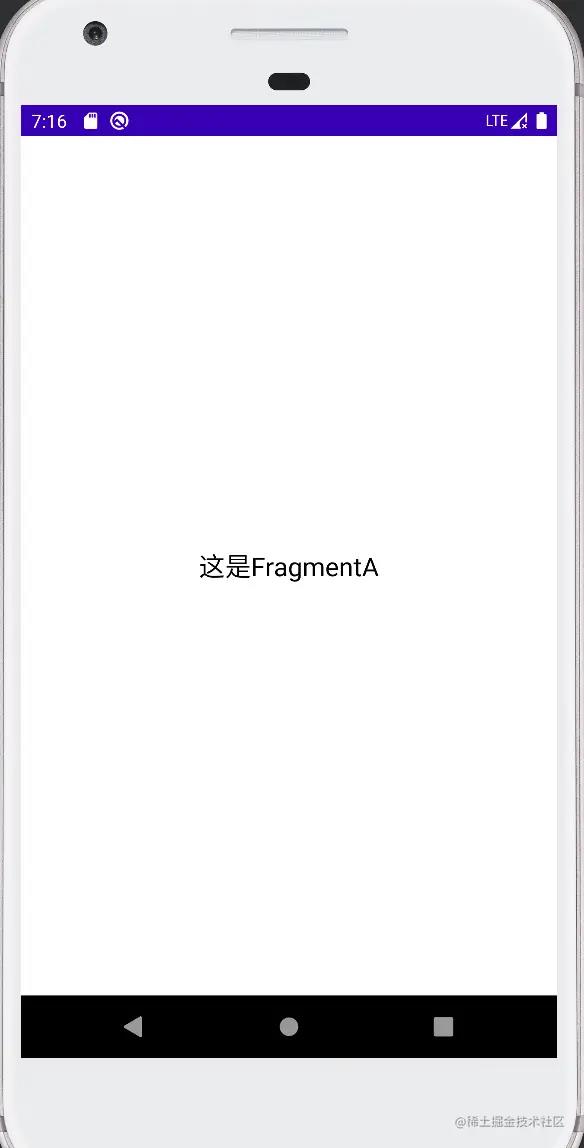
这样默认展示了FragmentA页面,因为在路由表中设置了起点就是fragmentA
1.1 页面跳转
前面只是完成了基础的准备工作,最关键的就是页面的跳转,那么就需要使用Navigation的能力
class NaviUtils
private var controller:NavController? = null
fun inject(fragmentManager: FragmentManager,containerId:Int)
val fragment = fragmentManager.findFragmentById(containerId) as NavHostFragment
controller = fragment.findNavController()
//动态设置路由表
fun inject(fragmentManager: FragmentManager,containerId:Int,naviGraph: Int)
val fragment = fragmentManager.findFragmentById(containerId) as NavHostFragment
controller = fragment.findNavController()
val graph = controller?.navInflater?.inflate(naviGraph)
controller?.graph = graph!!
//动态加载路由表,设置路由起点
fun inject(fragmentManager: FragmentManager,containerId:Int,naviGraph: Int,startDestination:Int)
val fragment = fragmentManager.findFragmentById(containerId) as NavHostFragment
controller = fragment.findNavController()
val graph = controller?.navInflater?.inflate(naviGraph)
graph?.setStartDestination(startDestination)
controller?.graph = graph!!
fun jump(id:Int)
controller?.navigate(id)
companion object
private val controllerMap: MutableMap<Activity, NaviUtils> by lazy
mutableMapOf()
fun register(activity: Activity): NaviUtils
if (!controllerMap.containsKey(activity))
controllerMap[activity] = NaviUtils()
return controllerMap[activity]!!
fun unregister(activity: Activity)
if (controllerMap.containsKey(activity))
controllerMap.remove(activity)
这里我写了一个关于Navigation路由的封装,首先NaviUtils是一个单例,提供了3个重载方法inject,如果想要拿到NavController,需要调用NavHostFragment的findNavController方法,NavHostFragment其实就是在Activity中提供容器能力的FragmentContainerView;
class NaviHolderActivity : AppCompatActivity()
private lateinit var binding:ActivityNaviHolderBinding
override fun onCreate(savedInstanceState: Bundle?)
super.onCreate(savedInstanceState)
binding = ActivityNaviHolderBinding.inflate(layoutInflater)
setContentView(binding.root)
NaviUtils.register(this).inject(supportFragmentManager,R.id.fragmentContainerView)
override fun onDestroy()
super.onDestroy()
NaviUtils.unregister(this)
在拿到NavController之后,调用其navigate方法就可以任意在路由表中跳转。例如从FragmentA跳转到FragmentB。
NaviUtils.register(requireActivity()).jump(R.id.action_fragmentA_to_fragmentB)
然后我们再加一个FragmentC,从A页面可以到C页面,从B页面也可以到C页面。之后如果新增其他页面,也需要跳转到C页面,这样的话,我们需要每个页面下都写一个到C的action,这样其实也没问题,但是其实是可以给抽出来做一个全局的action
<?xml version="1.0" encoding="utf-8"?>
<navigation xmlns:android="http://schemas.android.com/apk/res/android"
xmlns:app="http://schemas.android.com/apk/res-auto"
android:id="@+id/navi_test"
app:startDestination="@id/fragmentA">
<fragment
android:id="@+id/fragmentA"
android:name="com.lay.image_process.navi.FragmentA"
android:label="FragmentA" >
<action
android:id="@+id/action_fragmentA_to_fragmentB"
app:destination="@id/fragmentB" />
<action
android:id="@+id/action_fragmentA_to_fragmentC"
app:destination="@id/fragmentC" />
</fragment>
<fragment
android:id="@+id/fragmentB"
android:name="com.lay.image_process.navi.FragmentB"
android:label="FragmentB" >
<action
android:id="@+id/action_fragmentB_to_fragmentC"
app:destination="@id/fragmentC" />
</fragment>
<fragment
android:id="@+id/fragmentC"
android:name="com.lay.image_process.navi.FragmentC"
android:label="FragmentC" />
</navigation>
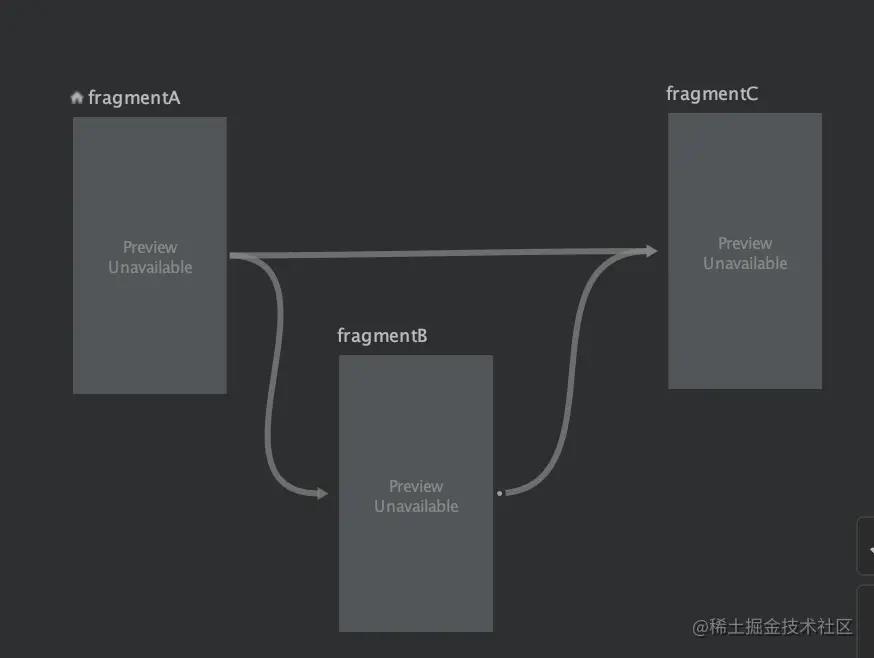
转换后的action
<?xml version="1.0" encoding="utf-8"?>
<navigation xmlns:android="http://schemas.android.com/apk/res/android"
xmlns:app="http://schemas.android.com/apk/res-auto"
android:id="@+id/navi_test"
app:startDestination="@id/fragmentA">
<action
android:id="@+id/to_fragmentC"
app:destination="@id/fragmentC" />
<fragment
android:id="@+id/fragmentA"
android:name="com.lay.image_process.navi.FragmentA"
android:label="FragmentA" >
<action
android:id="@+id/action_fragmentA_to_fragmentB"
app:destination="@id/fragmentB" />
</fragment>
<fragment
android:id="@+id/fragmentB"
android:name="com.lay.image_process.navi.FragmentB"
android:label="FragmentB" >
</fragment>
<fragment
android:id="@+id/fragmentC"
android:name="com.lay.image_process.navi.FragmentC"
android:label="FragmentC" />
</navigation>
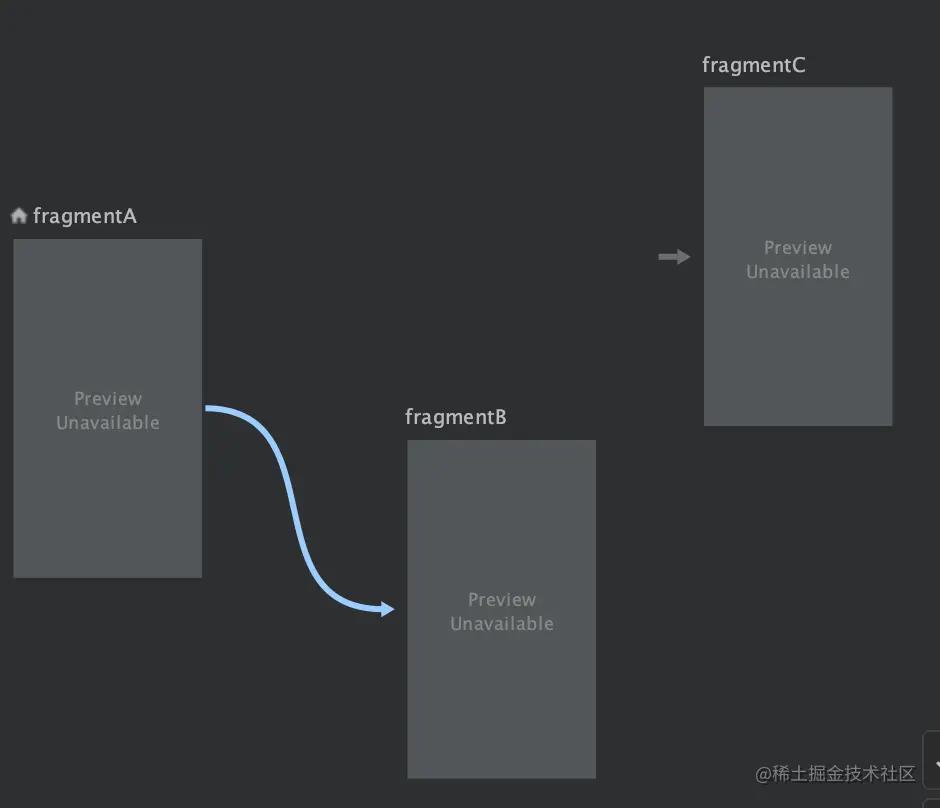
路由表也看的比较清晰了
NaviUtils.register(requireActivity()).jump(R.id.to_fragmentC)
putString("msg","这是从A页面传递过来的信息")
1.2 回退栈
对于Navigation回退栈,也有相关的api可以借鉴
fun backStack()
controller?.popBackStack()
fun backStack(desId:Int,popInclusive:Boolean)
controller?.popBackStack(desId,popInclusive)
例如,从A页面到B页面,如果返回到A页面,那么就可以调用backStack方法;像这种进入退出都可以使用popBackStack来进行退栈处理;
如果从A跳转到B,从B跳转到C,然后从C退出后,直接回到A页面,该如何处理?
因为popBackStack返回只能返回到上一级,如果我们设置一个路由,从C直接到A是不是就可以解决了呢?试一下
<action
android:id="@+id/to_fragmentA"
app:destination="@id/fragmentA"/>
显然不可以,虽然跳转到了A页面,但是点击app退出的时候,又回到了C页面,因此在内存中还存在B C页面的任务栈,所以想要清除B C页面任务栈,需要两个属性popUpTo和popUpToInclusive
<action
android:id="@+id/to_fragmentA"
app:destination="@id/fragmentA"
app:popUpTo="@id/fragmentA"
app:popUpToInclusive="true"/>
使用popUpTo,那么除了fragmentA之外,其他所有的页面都会出栈,那么在跳转到A页面之后,点返回按钮就直接退出app了。
当然这是静态处理,那么如果想动态配置,那么可以调用NaviUtils中的backStack第二个重载函数。
NaviUtils.register(requireActivity()).backStack(R.id.fragmentA,true)
这个方法其实与上述XML布局中描述的一致
1.3 Fragment间数据传递
在前言中,我们提到了Fragment之间数据传递,其实如果使用Navigation,Fragment之间数据传递就太简单了,我们在NaviUtils中添加一个方法
fun jump(id: Int, args: Bundle.() -> Unit)
val bundle = Bundle()
bundle.args()
controller?.navigate(id, bundle)
当页面跳转时,可以携带参数进行传递
NaviUtils.register(requireActivity()).jump(R.id.action_fragmentA_to_fragmentB)
putString("msg","这是从A页面传递过来的信息")
那么在B页面就可以接受参数:
arguments?.let
val msg = it.getString("msg")
binding.tvMsg.text = msg
2 Navigation原理分析
本小节源码为kotlin源码,其实与Java版本基本一致,如果不熟悉Kotlin的小伙伴也可以跟一下,明白原理即可
2.1 NavHostFragment
从本文一开始准备工作中知道,路由表是放在NavHostFragment当中的,所以先从NavHostFragment中的源码看起,NavHostFragment其实也是一个Fragment,并实现了NavHost接口
public interface NavHost
/**
* The [navigation controller][NavController] for this navigation host.
*/
public val navController: NavController
在NavHost接口中,有一个成员变量navController,其实就是我们用来配置导航的工具类,在NaviUtils中,我们通过id获取到NavHostFragment之后,拿到了NavController对象。
@CallSuper
public override fun onCreate(savedInstanceState: Bundle?)
var context = requireContext()
navHostController = NavHostController(context)
navHostController!!.setLifecycleOwner(this)
while (context is ContextWrapper)
if (context is OnBackPressedDispatcherOwner)
navHostController!!.setOnBackPressedDispatcher(
(context as OnBackPressedDispatcherOwner).onBackPressedDispatcher
)
// Otherwise, caller must register a dispatcher on the controller explicitly
// by overriding onCreateNavHostController()
break
context = context.baseContext
// Set the default state - this will be updated whenever
// onPrimaryNavigationFragmentChanged() is called
navHostController!!.enableOnBackPressed(
isPrimaryBeforeOnCreate != null && isPrimaryBeforeOnCreate as Boolean
)
isPrimaryBeforeOnCreate = null
navHostController!!.setViewModelStore(viewModelStore)
//创建navigator
onCreateNavHostController(navHostController!!)
var navState: Bundle? = null
if (savedInstanceState != null)
navState = savedInstanceState.getBundle(KEY_NAV_CONTROLLER_STATE)
if (savedInstanceState.getBoolean(KEY_DEFAULT_NAV_HOST, false))
defaultNavHost = true
parentFragmentManager.beginTransaction()
.setPrimaryNavigationFragment(this)
.commit()
graphId = savedInstanceState.getInt(KEY_GRAPH_ID)
if (navState != null)
// Navigation controller state overrides arguments
navHostController!!.restoreState(navState)
if (graphId != 0)
// Set from onInflate()
navHostController!!.setGraph(graphId)
else
// See if it was set by NavHostFragment.create()
val args = arguments
val graphId = args?.getInt(KEY_GRAPH_ID) ?: 0
val startDestinationArgs = args?.getBundle(KEY_START_DESTINATION_ARGS)
if (graphId != 0)
navHostController!!.setGraph(graphId, startDestinationArgs)
// We purposefully run this last as this will trigger the onCreate() of
// child fragments, which may be relying on having the NavController already
// created and having its state restored by that point.
super.onCreate(savedInstanceState)
navController是在NavHostFragment的onCreate方法中初始化的,这里是创建了一个NavHostController对象,这个类的父类就是NavController
final override val navController: NavController
get()
checkNotNull(navHostController) "NavController is not available before onCreate()"
return navHostController as NavHostController
我们看下NavController的构造方法,我们可以看到,当创建NavController时,在_navigatorProvider中添加了2个Navigator
init
_navigatorProvider.addNavigator(NavGraphNavigator(_navigatorProvider))
_navigatorProvider.addNavigator(ActivityNavigator(context))
NavigatorProvider是什么,我们可以把他当做是路由表的提供者,我们之前写过的路由表navi_test就是其中之一,而且我们可以看到路由表中不仅仅支持Fragment,还支持NavGraph、Activity等
public open var navigatorProvider: NavigatorProvider
get() = _navigatorProvider
/**
* @hide
*/
set(navigatorProvider)
check(backQueue.isEmpty()) "NavigatorProvider must be set before setGraph call"
_navigatorProvider = navigatorProvider
先不着急看,回到之前的代码中,我们在创建了NavController之后,调用了NaviHostFragment的onCreateNavController方法,将NavController传递了进去,我们可以看到,又往NavController的navigatorProvider中添加了DialogFragmentNavigator和FragmentNavigator
protected open fun onCreateNavController(navController: NavController)
navController.navigatorProvider +=
DialogFragmentNavigator(requireContext(), childFragmentManager)
navController.navigatorProvider.addNavigator(createFragmentNavigator())
2.2 Navigator
我们看到,在NavHostFragment的onCreate方法中,创建了多种Navigator,并添加到了NavController的navigatorProvider中,那么Navigator是什么呢?我们看下源码
public abstract class Navigator<D : NavDestination>
/**
* This annotation should be added to each Navigator subclass to denote the default name used
* to register the Navigator with a [NavigatorProvider].
*
* @see NavigatorProvider.addNavigator
* @see NavigatorProvider.getNavigator
*/
@kotlin.annotation.Retention(AnnotationRetention.RUNTIME)
@Target(AnnotationTarget.ANNOTATION_CLASS, AnnotationTarget.CLASS)
public annotation class Name(val value: String)
private var _state: NavigatorState? = null
/**
* Construct a new NavDestination associated with this Navigator.
*
* Any initialization of the destination should be done in the destination's constructor as
* it is not guaranteed that every destination will be created through this method.
* @return a new NavDestination
*/
public abstract fun createDestination(): D
/**
* Navigate to a destination.
*
* Requests navigation to a given destination associated with this navigator in
* the navigation graph. This method generally should not be called directly;
* [NavController] will delegate to it when appropriate.
*
* @param entries destination(s) to navigate to
* @param navOptions additional options for navigation
* @param navigatorExtras extras unique to your Navigator.
*/
@Suppress("UNCHECKED_CAST")
public open fun navigate(
entries: List<NavBackStackEntry>,
navOptions: NavOptions?,
navigatorExtras: Extras?
)
entries.asSequence().map backStackEntry ->
val destination = backStackEntry.destination as? D ?: return@map null
val navigatedToDestination = navigate(
destination, backStackEntry.arguments, navOptions, navigatorExtras
)
when (navigatedToDestination)
null -> null
destination -> backStackEntry
else ->
state.createBackStackEntry(
navigatedToDestination,
navigatedToDestination.addInDefaultArgs(backStackEntry.arguments)
)
.filterNotNull().forEach backStackEntry ->
state.push(backStackEntry)
/**
* Navigate to a destination.
*
* Requests navigation to a given destination associated with this navigator in
* the navigation graph. This method generally should not be called directly;
* [NavController] will delegate to it when appropriate.
*
* @param destination destination node to navigate to
* @param args arguments to use for navigation
* @param navOptions additional options for navigation
* @param navigatorExtras extras unique to your Navigator.
* @return The NavDestination that should be added to the back stack or null if
* no change was made to the back stack (i.e., in cases of single top operations
* where the destination is already on top of the back stack).
*/
// TODO Deprecate this method once all call sites are removed
@Suppress("UNUSED_PARAMETER", "RedundantNullableReturnType")
public open fun navigate(
destination: D,
args: Bundle?,
navOptions: NavOptions?,
navigatorExtras: Extras?
): NavDestination? = destination
/**
* Attempt to pop this navigator's back stack, performing the appropriate navigation.
*
* All destinations back to [popUpTo] should be popped off the back stack.
*
* @param popUpTo the entry that should be popped off the [NavigatorState.backStack]
* along with all entries above this entry.
* @param savedState whether any Navigator specific state associated with [popUpTo] should
* be saved to later be restored by a call to [navigate] with [NavOptions.shouldRestoreState].
*/
@Suppress("UNUSED_PARAMETER")
public open fun popBackStack(popUpTo: NavBackStackEntry, savedState: Boolean)
val backStack = state.backStack.value
check(backStack.contains(popUpTo))
"popBackStack was called with $popUpTo which does not exist in back stack $backStack"
val iterator = backStack.listIterator(backStack.size)
var lastPoppedEntry: NavBackStackEntry? = null
do
if (!popBackStack())
// Quit early if popBackStack() returned false
break
lastPoppedEntry = iterator.previous()
while (lastPoppedEntry != popUpTo)
if (lastPoppedEntry != null)
state.pop(lastPoppedEntry, savedState)
/**
* Attempt to pop this navigator's back stack, performing the appropriate navigation.
*
* Implementations should return `true` if navigation
* was successful. Implementations should return `false` if navigation could not
* be performed, for example if the navigator's back stack was empty.
*
* @return `true` if pop was successful
*/
// TODO Deprecate this method once all call sites are removed
public open fun popBackStack(): Boolean = true
/**
* Called to ask for a [Bundle] representing the Navigator's state. This will be
* restored in [onRestoreState].
*/
public open fun onSaveState(): Bundle?
return null
/**
* Restore any state previously saved in [onSaveState]. This will be called before
* any calls to [navigate] or
* [popBackStack].
*
* Calls to [createDestination] should not be dependent on any state restored here as
* [createDestination] can be called before the state is restored.
*
* @param savedState The state previously saved
*/
public open fun onRestoreState(savedState: Bundle)
/**
* Interface indicating that this class should be passed to its respective
* [Navigator] to enable Navigator specific behavior.
*/
public interface Extras
我们这里挑几个核心方法看下,首先createDestination,是创建了一个新的NavDestination,其实我们可以把它看做是一个页面,例如下面的FragmentA,就是一个NavDestination
<fragment
android:id="@+id/fragmentA"
android:name="com.lay.image_process.navi.FragmentA"
android:label="FragmentA" >
<action
android:id="@+id/action_fragmentA_to_fragmentB"
app:destination="@id/fragmentB" />
</fragment>
然后核心的就是navigate方法,其实我们已经调用过这个方法了,只是通过NavController来调用的,既然在NavController中存在NavigatorProvider存储这些Navigator,我们就能想到,有可能就是调用这个方法,我们先分别看下不同的Navigator的navigate方法是什么样的:
(1)FragmentNavigator # navigate
private fun createFragmentTransaction(
entry: NavBackStackEntry,
navOptions: NavOptions?
): FragmentTransaction
//这里的 Destination就是即将跳转到的页面
val destination = entry.destination as Destination
val args = entry.arguments
var className = destination.className
if (className[0] == '.')
className = context.packageName + className
//每次跳转,都会新建一个新的Fragment
val frag = fragmentManager.fragmentFactory.instantiate(context.classLoader, className)
frag.arguments = args
val ft = fragmentManager.beginTransaction()
var enterAnim = navOptions?.enterAnim ?: -1
var exitAnim = navOptions?.exitAnim ?: -1
var popEnterAnim = navOptions?.popEnterAnim ?: -1
var popExitAnim = navOptions?.popExitAnim ?: -1
if (enterAnim != -1 || exitAnim != -1 || popEnterAnim != -1 || popExitAnim != -1)
enterAnim = if (enterAnim != -1) enterAnim else 0
exitAnim = if (exitAnim != -1) exitAnim else 0
popEnterAnim = if (popEnterAnim != -1) popEnterAnim else 0
popExitAnim = if (popExitAnim != -1) popExitAnim else 0
ft.setCustomAnimations(enterAnim, exitAnim, popEnterAnim, popExitAnim)
ft.replace(containerId, frag)
ft.setPrimaryNavigationFragment(frag)
ft.setReorderingAllowed(true)
return ft
我们可以看到,Fragment之间的跳转,是通过事务的replace方法,而且每次跳转到新的页面,都会重新创建
(2)DialogFragmentNavigator # navigate
private fun navigate(
entry: NavBackStackEntry
)
val destination = entry.destination as Destination
var className = destination.className
if (className[0] == '.')
className = context.packageName + className
val frag = fragmentManager.fragmentFactory.instantiate(
context.classLoader, className
)
require(DialogFragment::class.java.isAssignableFrom(frag.javaClass))
"Dialog destination $destination.className is not an instance of DialogFragment"
val dialogFragment = frag as DialogFragment
dialogFragment.arguments = entry.arguments
dialogFragment.lifecycle.addObserver(observer)
dialogFragment.show(fragmentManager, entry.id)
state.push(entry)
DialogFragment虽然是一个Fragment,但是也是弹窗的形式存在,因此展示的时候,采用Dialog常用的show方法也是理所应当的了。
(3)ActivityNavigator # navigate
override fun navigate(
destination: Destination,
args: Bundle?,
navOptions: NavOptions?,
navigatorExtras: Navigator.Extras?
): NavDestination?
checkNotNull(destination.intent)
("Destination $destination.id does not have an Intent set.")
val intent = Intent(destination.intent)
//......
val destId = destination.id
intent.putExtra(EXTRA_NAV_CURRENT, destId)
val resources = context.resources
if (navOptions != null)
val popEnterAnim = navOptions.popEnterAnim
val popExitAnim = navOptions.popExitAnim
if (
popEnterAnim > 0 && resources.getResourceTypeName(popEnterAnim) == "animator" ||
popExitAnim > 0 && resources.getResourceTypeName(popExitAnim) == "animator"
)
Log.w(
LOG_TAG,
"Activity destinations do not support Animator resource. Ignoring " +
"popEnter resource $resources.getResourceName(popEnterAnim) and " +
"popExit resource $resources.getResourceName(popExitAnim) when " +
"launching $destination"
)
else
// For use in applyPopAnimationsToPendingTransition()
intent.putExtra(EXTRA_POP_ENTER_ANIM, popEnterAnim)
intent.putExtra(EXTRA_POP_EXIT_ANIM, popExitAnim)
if (navigatorExtras is Extras)
val activityOptions = navigatorExtras.activityOptions
if (activityOptions != null)
ActivityCompat.startActivity(context, intent, activityOptions.toBundle())
else
context.startActivity(intent)
else
context.startActivity(intent)
if (navOptions != null && hostActivity != null)
var enterAnim = navOptions.enterAnim
var exitAnim = navOptions.exitAnim
if (
enterAnim > 0 && (resources.getResourceTypeName(enterAnim) == "animator") ||
exitAnim > 0 && (resources.getResourceTypeName(exitAnim) == "animator")
)
Log.w(
LOG_TAG,
"Activity destinations do not support Animator resource. " +
"Ignoring " + "enter resource " + resources.getResourceName(enterAnim) +
" and exit resource " + resources.getResourceName(exitAnim) + "when " +
"launching " + destination
)
else if (enterAnim >= 0 || exitAnim >= 0)
enterAnim = enterAnim.coerceAtLeast(0)
exitAnim = exitAnim.coerceAtLeast(0)
hostActivity.overridePendingTransition(enterAnim, exitAnim)
// You can't pop the back stack from the caller of a new Activity,
// so we don't add this navigator to the controller's back stack
return null
看了前面两个,对于Activity的启动方式,大概率就是通过startActivity来实现的了;
其实看到这里,我们就大概知道了,Navigation路由表中支持的节点类型了,而且每个Navigator都包装了一个页面,每个类型的Navigator都有自己展示的形式
<activity></activity>
<dialog></dialog>
<NoOp></NoOp>
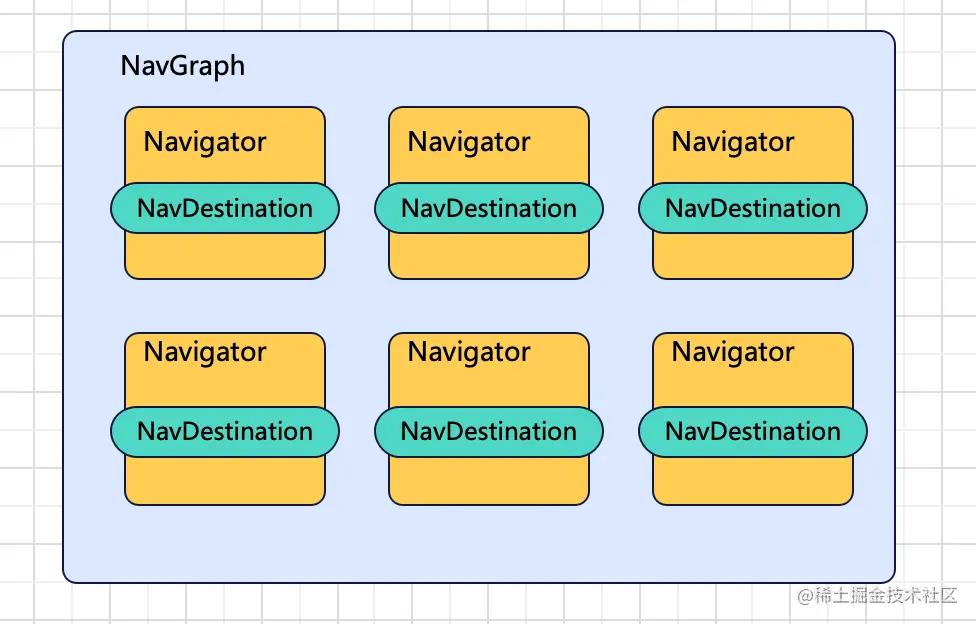
2.3 navigation布局文件解析
在之前NaviUtils中,inject有3个重载方法,然后第二个重载方法支持动态加载路由表,我们看到的是,通过NavController解析路由表,然后调用setGraph方法,将解析后的路由表添加进去
//动态设置路由表
fun inject(fragmentManager: FragmentManager,containerId:Int,naviGraph: Int)
val fragment = fragmentManager.findFragmentById(containerId) as NavHostFragment
controller = fragment.findNavController()
val graph = controller?.navInflater?.inflate(naviGraph)
controller?.graph = graph!!
在NavController中有一个成员变量,就是NavInflater对象,看名字就是路由解析器,类似于LayoutInflater
public open val navInflater: NavInflater by lazy
inflater ?: NavInflater(context, _navigatorProvider)
通过调用NavInflater的inflate方法,获取到一个NavGraph对象;首先我们先不看NavGraph是什么,我们看到inflate方法传入一个参数graphResId,这个就是我们的路由表文件R.navigation.xxx,它是通过XmlPullParser进行XML解析
public fun inflate(@NavigationRes graphResId: Int): NavGraph
val res = context.resources
val parser = res.getXml(graphResId)
val attrs = Xml.asAttributeSet(parser)
return try
var type: Int
while (parser.next().also type = it != XmlPullParser.START_TAG &&
type != XmlPullParser.END_DOCUMENT
) /* Empty loop */
if (type != XmlPullParser.START_TAG)
throw XmlPullParserException("No start tag found")
val rootElement = parser.name
val destination = inflate(res, parser, attrs, graphResId)
require(destination is NavGraph)
"Root element <$rootElement> did not inflate into a NavGraph"
destination
catch (e: Exception)
throw RuntimeException(
"Exception inflating $res.getResourceName(graphResId) line $parser.lineNumber",
e
)
finally
parser.close()
通过2.2小节中对于Navigator的了解,我们知道NavGraph也是一种节点类型,而且一张路由表中全部的节点都是存在navigatorProvider中,然后在inflate方法中,根据路由表中节点的名字,例如fragment、dialog、action等,获取其对应的Navigator类型,然后创建其对应的Destination对象
@Throws(XmlPullParserException::class, IOException::class)
private fun inflate(
res: Resources,
parser: XmlResourceParser,
attrs: AttributeSet,
graphResId: Int
): NavDestination
val navigator = navigatorProvider.getNavigator<Navigator<*>>(parser.name)
val dest = navigator.createDestination()
dest.onInflate(context, attrs)
val innerDepth = parser.depth + 1
var type: Int
var depth = 0
while (parser.next().also type = it != XmlPullParser.END_DOCUMENT &&
(parser.depth.also depth = it >= innerDepth || type != XmlPullParser.END_TAG)
)
if (type != XmlPullParser.START_TAG)
continue
if (depth > innerDepth)
continue
val name = parser.name
if (TAG_ARGUMENT == name)
inflateArgumentForDestination(res, dest, attrs, graphResId)
else if (TAG_DEEP_LINK == name)
inflateDeepLink(res, dest, attrs)
else if (TAG_ACTION == name)
inflateAction(res, dest, attrs, parser, graphResId)
else if (TAG_INCLUDE == name && dest is NavGraph)
res.obtainAttributes(attrs, androidx.navigation.R.styleable.NavInclude).use
val id = it.getResourceId(androidx.navigation.R.styleable.NavInclude_graph, 0)
dest.addDestination(inflate(id))
else if (dest is NavGraph)
dest.addDestination(inflate(res, parser, attrs, graphResId))
return dest
然后再往下看,是一个while循环,遍历路由表中全部的节点,然后会判断每个节点中标签
private const val TAG_ARGUMENT = "argument"
private const val TAG_DEEP_LINK = "deepLink"
private const val TAG_ACTION = "action"
private const val TAG_INCLUDE = "include"
将参数赋值给当前节点并返回,最终遍历完成全部节点之后,会返回一个NavGraph对象,调用NavController的setGraph方法,传入这个路由表
public open var graph: NavGraph
@MainThread
get()
checkNotNull(_graph) "You must call setGraph() before calling getGraph()"
return _graph as NavGraph
@MainThread
@CallSuper
set(graph)
setGraph(graph, null)
我们继续看下setGraph方法,我们可以看到,如果是两张不同的路由表,那么就会直接进行替换,重新加载生成新的路由表
public open fun setGraph(graph: NavGraph, startDestinationArgs: Bundle?)
if (_graph != graph)
_graph?.let previousGraph ->
// Clear all saved back stacks by iterating through a copy of the saved keys,
// thus avoiding any concurrent modification exceptions
val savedBackStackIds = ArrayList(backStackMap.keys)
savedBackStackIds.forEach id ->
clearBackStackInternal(id)
// Pop everything from the old graph off the back stack
popBackStackInternal(previousGraph.id, true)
_graph = graph
onGraphCreated(startDestinationArgs)
else
for (i in 0 until graph.nodes.size())
val newDestination = graph.nodes.valueAt(i)
_graph!!.nodes.replace(i, newDestination)
backQueue.filter currentEntry ->
// Necessary since CI builds against ToT, can be removed once
// androidx.collection is updated to >= 1.3.*
@Suppress("UNNECESSARY_SAFE_CALL", "SAFE_CALL_WILL_CHANGE_NULLABILITY")
currentEntry.destination.id == newDestination?.id
.forEach entry ->
entry.destination = newDestination
如果是两张一样的路由表,那么只会针对路由表中的节点进行替换,例如fragment中某个action发生变化,或者路由表的起点startDestination属性发生变化,但是需要注意是一定要重新调用setGraph方法才会生效。
所以,当我们获取到了NavController之后,就相当于已经获取到了路由表中的全部节点,就能够灵活地实现跳转、传参等操作。
2.4 小结
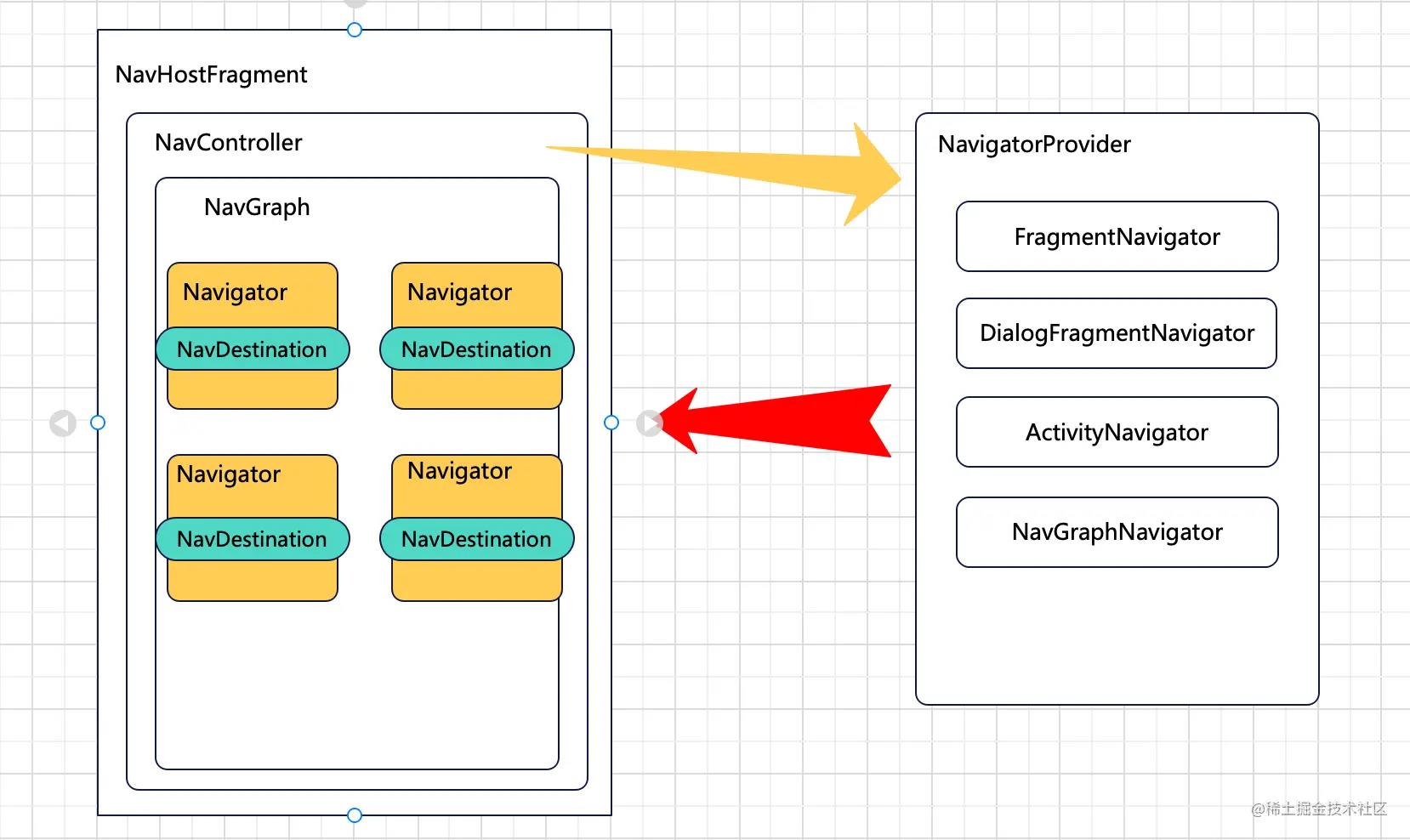
我这边画了一张图,总结一下Navigation是如何运作的:
(1)承载路由表的容器是NavHostFragment,它也是一个Fragment,因此在其初始化的时候,会调用其生命周期onCreate方法,在这个方法中完成NavController的初始化;
(2)在NavController中,存在一个Map集合,用于存储路由表中的节点,而且支持4种类型,分别为fragment、dialog、activity、navgraph,在NavController的构造方法中初始化完成;
(3)NavController初始化完成之后,将会解析默认的路由表,路由表解析是通过XmlPullParser来完成的,会通过while循环遍历获取节点,然后通过NavigatorProvider获取当前节点的类型,创建对应的页面,最终解析完成后,是将路由表转换为NavGraph对象
还有就是对于Navigator与NavDestination的关系就是:具体的NavDestination是通过特定的Navigator创建的(调用createDestination方法),里面存储了当前节点的信息
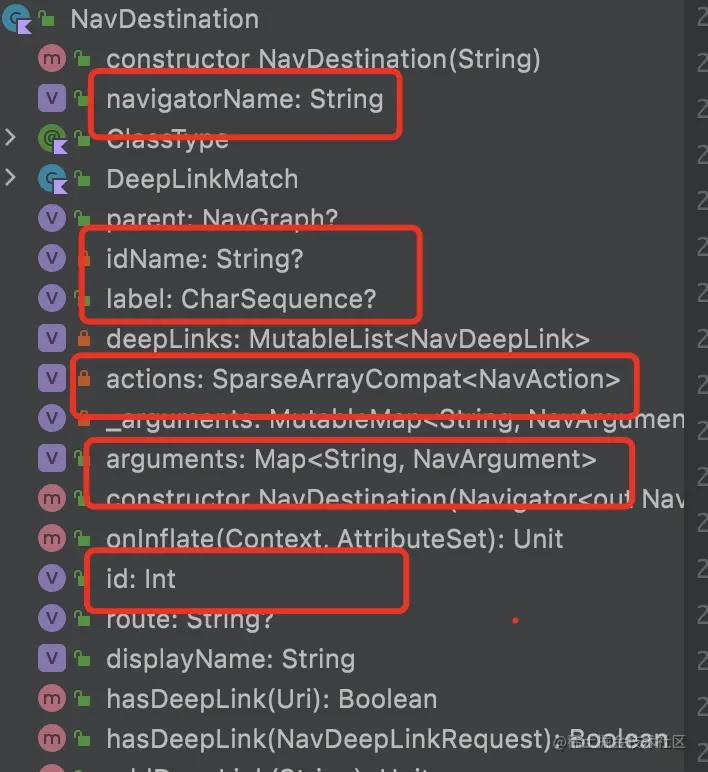
但是页面之间跳转的逻辑,都是由Navigator来实现的,所以我们在调用NavController来进行页面跳转的时候,其实真正的执行类就是Navigator,伙伴们都明白了吧。
3 Navigation优化
我们从之前源码中可以看到,当每次调用navigate方法的时候,都会新建一个Fragment的,而且无论当前Fragment是否已经存在了,都会新建,这样的话其实是比较浪费资源的,我们可以先验证一下。
2022-09-25 14:27:19.885 23844-23844/com.lay.image_process D/TAG: FragmentA onCreateView
2022-09-25 14:28:36.009 23844-23844/com.lay.image_process D/TAG: FragmentB onCreateView
2022-09-25 14:28:37.786 23844-23844/com.lay.image_process D/TAG: FragmentC onCreateView
2022-09-25 14:28:41.311 23844-23844/com.lay.image_process D/TAG: FragmentA onCreateView
从A切换到B,从B到C,再从C到A,每次跳转都是创建一个新的Fragment,那么罪魁祸首就是FragmentNavigator的navigate方法,跳转的方式是通过replace的方式,将新建的Fragment替换
val frag = fragmentManager.fragmentFactory.instantiate(context.classLoader, className)
frag.arguments = args
val ft = fragmentManager.beginTransaction()
var enterAnim = navOptions?.enterAnim ?: -1
var exitAnim = navOptions?.exitAnim ?: -1
var popEnterAnim = navOptions?.popEnterAnim ?: -1
var popExitAnim = navOptions?.popExitAnim ?: -1
if (enterAnim != -1 || exitAnim != -1 || popEnterAnim != -1 || popExitAnim != -1)
enterAnim = if (enterAnim != -1) enterAnim else 0
exitAnim = if (exitAnim != -1) exitAnim else 0
popEnterAnim = if (popEnterAnim != -1) popEnterAnim else 0
popExitAnim = if (popExitAnim != -1) popExitAnim else 0
ft.setCustomAnimations(enterAnim, exitAnim, popEnterAnim, popExitAnim)
ft.replace(containerId, frag)
那么既然系统的方案是这么做的,那么我们也可以通过自己创建Navigator改变这种交互方式。
3.1 自定义Navigator
因为Fragment的创建,是通过FragmentNavigator来完成,因此如果想要修改Fragment的启动方式,通过继承FragmentNavigator,重写navigate方法即可。
通过前面对源码的解读,我们知道这个问题处理的核心就是解决createFragmentTransaction方法中Fragment的展示方式,处理方式如下:
val ft = fragmentManager.beginTransaction()
//首先获取当前展示的Fragment
val primaryNavigationFragment = fragmentManager.primaryNavigationFragment
//将当前展示的Fragment隐藏
ft.hide(primaryNavigationFragment!!)
//获取即将展示的Fragment
val tag = destination.id.toString()
var frag = fragmentManager.findFragmentByTag(tag)
//如果在fragmentManager中能获取到这个Fragment,说明已经创建过这个Fragment
if (frag != null)
ft.show(frag)
else
//如果没有,就需要创建新的Fragment
frag = fragmentManager.fragmentFactory.instantiate(context.classLoader, className)
//将其放入fragmentManager中
frag.arguments = args
ft.add(frag, tag)
对于Fragment的显示和隐藏,通过FragmentTransaction来实现,对于没有创建过的Fragment是采用Navigation中原有的实现逻辑,创建新的Fragment,并添加到FragmentManager中,方便下次获取。
class MyFragmentNavigator(
private val context: Context,
private val fragmentManager: FragmentManager,
private val containerId: Int
) : FragmentNavigator(context, fragmentManager, containerId)
private var savedIds: MutableSet<String>? = null
override fun navigate(
entries: List<NavBackStackEntry>,
navOptions: NavOptions?,
navigatorExtras: Navigator.Extras?
)
if (fragmentManager.isStateSaved)
Log.i(
TAG, "Ignoring navigate() call: FragmentManager has already saved its state"
)
return
for (entry in entries)
navigate(entry, navOptions, navigatorExtras)
private fun navigate(
entry: NavBackStackEntry,
navOptions: NavOptions?,
navigatorExtras: Navigator.Extras?
)
//获取saveIds
val savedIdsField = FragmentNavigator.javaClass.getDeclaredField("savedIds")
savedIdsField.isAccessible = true
//获取这个属性的值
savedIds = savedIdsField.get(this) as MutableSet<String>
val initialNavigation = state.backStack.value.isEmpty()
val restoreState = (
navOptions != null && !initialNavigation &&
navOptions.shouldRestoreState() &&
savedIds!!.remove(entry.id)
)
if (restoreState)
// Restore back stack does all the work to restore the entry
fragmentManager.restoreBackStack(entry.id)
state.push(entry)
return
val ft = createFragmentTransaction(entry, navOptions)
if (!initialNavigation)
ft.addToBackStack(entry.id)
if (navigatorExtras is Extras)
for ((key, value) in navigatorExtras.sharedElements)
ft.addSharedElement(key, value)
ft.commit()
// The commit succeeded, update our view of the world
state.push(entry)
private fun createFragmentTransaction(
entry: NavBackStackEntry,
navOptions: NavOptions?
): FragmentTransaction
val destination = entry.destination as Destination
val args = entry.arguments
var className = destination.className
if (className[0] == '.')
className = context.packageName + className
val ft = fragmentManager.beginTransaction()
//首先获取当前展示的Fragment
val primaryNavigationFragment = fragmentManager.primaryNavigationFragment
//将当前展示的Fragment隐藏
ft.hide(primaryNavigationFragment!!)
//获取即将展示的Fragment
val tag = destination.id.toString()
var frag = fragmentManager.findFragmentByTag(tag)
//如果在fragmentManager中能获取到这个Fragment,说明已经创建过这个Fragment
if (frag != null)
ft.show(frag)
else
//如果没有,就需要创建新的Fragment
frag = fragmentManager.fragmentFactory.instantiate(context.classLoader, className)
//将其放入fragmentManager中
frag.arguments = args
//注意这里需要加到containerId里,不然不会显示Fragment的UI
ft.add(containerId,frag, tag)
var enterAnim = navOptions?.enterAnim ?: -1
var exitAnim = navOptions?.exitAnim ?: -1
var popEnterAnim = navOptions?.popEnterAnim ?: -1
var popExitAnim = navOptions?.popExitAnim ?: -1
if (enterAnim != -1 || exitAnim != -1 || popEnterAnim != -1 || popExitAnim != -1)
enterAnim = if (enterAnim != -1) enterAnim else 0
exitAnim = if (exitAnim != -1) exitAnim else 0
popEnterAnim = if (popEnterAnim != -1) popEnterAnim else 0
popExitAnim = if (popExitAnim != -1) popExitAnim else 0
ft.setCustomAnimations(enterAnim, exitAnim, popEnterAnim, popExitAnim)
ft.setPrimaryNavigationFragment(frag)
ft.setReorderingAllowed(true)
return ft
companion object
private const val TAG = "MyFragmentNavigator"
3.2 自定义Navigator注入
既然我们写了一个自己的MyFragmentNavigator,那么怎么能放在navigation这个框架里使用呢?我们先看下原始的FragmentNavigator,有一个Navigator.Name的注解,细心的伙伴可能就发现了,这个就是我们在路由表中加入的标签。
@Navigator.Name("fragment")
public open class FragmentNavigator(
private val context: Context,
private val fragmentManager: FragmentManager,
private val containerId: Int
) : Navigator<Destination>()
那么我们也可以自己定义一个标签 - my_fragment,这样当解析到这类标签的时候,就会使用我们自定义的CustomFragmentNavigator去创建页面,页面之间的跳转也会使用我们自定义的navigate,从而避免重复创建的问题
@Navigator.Name("my_fragment")
class CustomFragmentNavigator(
private val context: Context,
private val fragmentManager: FragmentManager,
private val containerId: Int
) : FragmentNavigator(context, fragmentManager, containerId)
通过前面源码的阅读,我们知道FragmentNavigator是在NavHostFragment的onCreate方法中,调用onCreateNavHostController中创建的,因此我们可以继承NavHostFragment,重写这个方法,将我们自定义的CustomFragmentNavigator添加到NavController中
class MyNavHostFragment : NavHostFragment()
override fun onCreateNavController(navController: NavController)
navController.navigatorProvider += CustomFragmentNavigator(
requireContext(),
fragmentManager = childFragmentManager,
id
)
super.onCreateNavController(navController)
这样,我们的navigation路由表需要做一些改造,将fragment标签换成我们自定义的my_fragment标签,即可实现我们的需求了。
<?xml version="1.0" encoding="utf-8"?>
<navigation xmlns:android="http://schemas.android.com/apk/res/android"
xmlns:app="http://schemas.android.com/apk/res-auto"
android:id="@+id/navi_test"
app:startDestination="@id/fragmentA">
<action
android:id="@+id/to_fragmentC"
app:destination="@id/fragmentC" />
<action
android:id="@+id/to_fragmentA"
app:destination="@id/fragmentA"/>
<my_fragment
android:id="@+id/fragmentA"
android:name="com.lay.image_process.navi.FragmentA"
android:label="FragmentA" >
<action
android:id="@+id/action_fragmentA_to_fragmentB"
app:destination="@id/fragmentB" />
</my_fragment>
<my_fragment
android:id="@+id/fragmentB"
android:name="com.lay.image_process.navi.FragmentB"
android:label="FragmentB" >
</my_fragment>
<my_fragment
android:id="@+id/fragmentC"
android:name="com.lay.image_process.navi.FragmentC"
android:label="FragmentC" />
</navigation>
还需要注意一点的就是,FragmentContainerView中的NavHostFragment要替换成我们自定义的NavHostFragment。
<androidx.fragment.app.FragmentContainerView
android:id="@+id/fragmentContainerView"
android:name="com.lay.image_process.utils.MyNavHostFragment"
android:layout_width="match_parent"
android:layout_height="match_parent"
app:defaultNavHost="true"
app:navGraph="@navigation/navi_test" />
我们可以自己验证一下,当使用Google原生的Navigation,跳转回退都会新建新的Fragment;当使用我们自己的Navigator后,就不再有这种情况。
作者:想要成为专家的Lay
链接:https://juejin.cn/post/7147265281973288973
更多Android学习资料可点击下方卡片了解~
以上是关于Android进阶宝典 -- JetPack Navigation的高级用法(解决路由跳转新建Fragment页面问题)的主要内容,如果未能解决你的问题,请参考以下文章